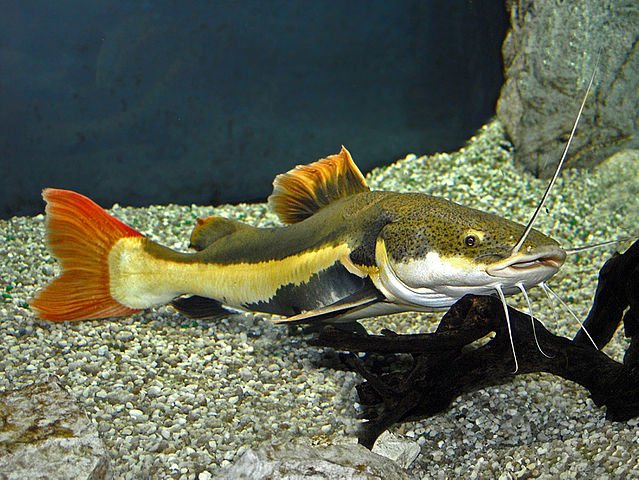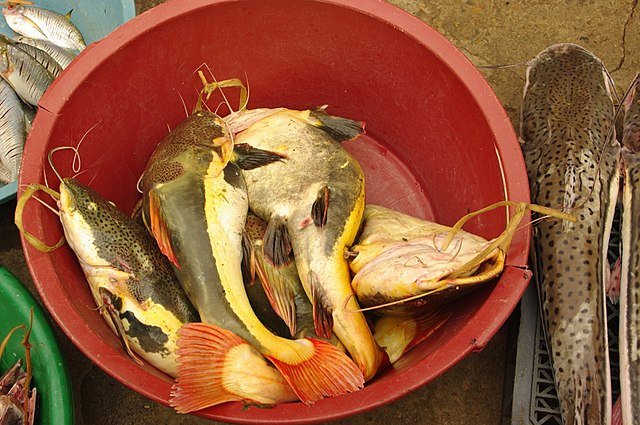The Redtail Catfish (Phractocephalus hemioliopterus) is a common fish in aquariums, and in recent years, there has been growing interest in developing the aquaculture of this catfish.
Redtail catfish have economic importance as they provide food and income to riparian communities, making them highly valued by fishermen. Despite their large size, P. hemioliopterus is also considered an ornamental fish.
In this article, we want to share information about the Redtail Catfish, including its main characteristics, feeding habits, reproduction, compatibility, and diseases.
Taxonomy
Kingdom: Animalia
Phylum: Chordata
Class: Actinopterygii
Subclass: Neopterygii
Infraclass: Teleostei
Superorder: Ostariophysi
Order: Siluriformes
Family: Pimelodidae
Genus: Phractocephalus
Species: Phractocephalus hemioliopterus (previously Silurus hemioliopterus, Phractocephalus bicolor)
Common Name: pez gato cola roja, bagre torre (Peru), General (Bolivia), Pirarara (Brazil), pez Guacamayo (Ecuador), and Cajaro (Colombia and Venezuela)
Characteristics of Redtail catfish
The Redtail Catfish (P. hemioliopterus) is the most colorful of the giant neotropical catfish species in the Pimelodidae family (Souza et al., 2012).
The Redtail Catfish has a fusiform body shape and can reach a length of 135 cm and a weight of 80 kg. However, its average size is around 1.1 – 1.4 m in length.
This type of catfish has three pairs of barbels that have both gustatory and olfactory/tactile areas, helping them locate their prey.
Phractocephalus hemioliopterus has a black-brown coloration on the upper part, yellow sides, and a white-colored belly. The main characteristic of this catfish is its completely red tail.
Redtail Catfish can live up to 15 years.

Habitat
The Redtail Catfish is native to South America. It is primarily found in the basins of the Amazon, Orinoco, and Esequibo rivers, in countries such as Ecuador, Venezuela, Guyana, Colombia, Peru, Bolivia, and Brazil.
This catfish species has been introduced to Florida (United States), Japan, and Malaysia.
It mainly inhabits the bottom of the main river channels and large streams. It is often found in rapids (cachuelas).
Feeding
Redtail catfish are primarily omnivorous. In their natural habitat, they feed on fish, shrimp, crabs, and occasionally fruits.
In captivity, Redtail catfish are fed mussels, prawns, fish chunks, earthworms, and even catfish feeds.
In captivity, juvenile Redtail catfish should be fed every 2 to 4 days, but once they reach adulthood, they should be fed once a week. Regarding this, de Oliveira et al. (2023) determined that juvenile Redtail catfish quickly adapt to self-feeding systems and prefer to feed at night.
Reproduction
Redtail catfish do not exhibit sexual dimorphism, so it is not possible to differentiate females from males at a glance. However, during the breeding season, female Redtail catfish typically have a more rounded belly.
Freitas et al. (2019) report that in their natural environment, Redtail catfish (P. hemioliopterus) reach sexual maturity at a size of 77.8 cm.
Redtail catfish reproduce through external fertilization after the female lays the eggs. A female Redtail catfish can lay a total of 300,000 to 500,000 eggs.
Rearing
Successful rearing of Redtail catfish, and any fish for that matter, requires not only good feeding practices but also maintaining proper water quality parameters to ensure they grow in a healthy environment that allows these fish to thrive.
Table 01. Water quality parameters for the care of Redtail catfish.
| Parameter | Range |
| Aquarium Size | Over 1000 liters for juveniles Over 10,000 liters for adults |
| Water Temperature | 20 – 26 oC |
| pH | 5.5 – 6.8 |
| Hardness (GH) | 2 – 10 |
| Decoration | The aquarium should include large logs and rocks to serve as caves and shelters. Equipment should be placed outside the tank. |
Decoration is not necessary for a tank containing an adult Redtail catfish. In this regard, it is recommended not to include small objects in the breeding tank that the Redtail catfish could ingest.
Similarly, the tank substrate should include a layer of large gravel.
On the other hand, if you are going to transport or monitor the growth of juvenile Redtail catfish, you can use a eugenol concentration of 70 mg/L to promote anesthesia induction in the fish (Dutra et al., 2021).
Compatibility
Redtail catfish are extremely territorial, so it is recommended to keep only one specimen per aquarium. However, if it is a large aquarium for public display, you can include other large fish species such as pacu and tambaqui.
On the other hand, juvenile Redtail catfish may prey on other fish in community aquariums (e.g., tetras or guppies).

Diseases
Ich or white spot disease
Neto and Souto (2020) treated Ich in Phractocephalus hemioliopterus specimens with sodium chloride in short baths at a concentration of 3%, resulting in a reduction in mortality.
Parasites
Oliveira et al. (2019) report that crustaceans such as Argulus multicolor, Argulus violaceus, Dolops nana, Dolops discoidalis, and Braga patagonica infest P. hemioliopterus, with Dolops discoidalis being the dominant ectoparasite.
Redtail catfish is infested by a series of ectoparasites that cause skin wounds. Andrade et al. (2023) determined that a topical treatment with 10 grams/m3 of potassium permanganate and 2 grams/m3 of methylene blue is suitable for curing the fish.
Economic and Nutritional Value of Redtail Catfish
Redtail catfish are highly valued by fishermen in riverine communities as a source of food and income. Additionally, in some regions, the fat and leather of the fish are used in folk medicine for respiratory problems.
In this regard, Pinto and Maduro (2003) report that one of the most commonly used animal products in folk medicine in the city of Boa Vista (Roraima, Brazil) is pirarara lard.
Redtail catfish is part of the diet of Amazonian peoples, being captured alongside other catfish species and sold in regional markets.
Sotelo et al. (2008) report that the protein content of Redtail catfish is 14.74%, and the moisture content is 81.8%. They also highlight that Redtail catfish has potential for surimi production and derived products.

Conclusion
“Redtail catfish” is the most colorful of the giant catfish species in the Amazon, which makes it more attractive to aquarium enthusiasts. However, due to its large size, it is necessary to rear them in tanks of considerable size.
On the other hand, the economic importance of this fish as a food and income source for riverine communities encourages its aquaculture, which is still in its early stages.
References
Andrade, R. B., Fernandes, M. P., Rezende, M. T. N. P., Alves, T. R. de O., & Rodrigues, L. (2023). Uso do azul de metileno e permanganato de potássio em lesão cutânea de Phractocephalus Hemioliopterus. Pubvet, 17(04), e1371. https://doi.org/10.31533/pubvet.v17n04e1371
de Oliveira Guilherme, H., Perez Ribeiro, P. A., Prado, V. G. L., Bahiense, R. N., Gamarano, P. G., de Oliveira, C. G., de Almeida Freitas, D., & Costa, L. S. (2023). Feeding behaviour, locomotion rhythms and blood biochemistry of the neotropical red-tail catfish (Phractocephalus hemioliopterus). Journal of Fish Biology, 102( 4), 803– 815. https://doi.org/10.1111/jfb.15317
Dutra, Janaína Alves, Garcia, Ronielson Soares, Araújo, Mollynsk Oliveira, Menezes, Ludmila Lopes de Castro, Souto, Cristielle Nunes. 2021. AVALIAÇÃO DO TEMPO DE INDUÇÃO E RETORNO COM O USO DO EUGENOL EM PIRARARA (Phractocephalus hemioliopterus). Aquaciencia Digital 2021.
EcuRed. Pez gato cola roja
Freitas, T. M. D. S., & Montag, L. F. D. A. (2019). Population and reproductive parameters of the red-tailed catfish, Phractocephalus hemioliopterus (Pimelodidae: Siluriformes), from the Xingu River, Brazil. Neotropical Ichthyology, 17.
Neto, J. M. D. S., & Souto, C. N. 2020. PIRARARA (Phractocephalus hemioliopterus) LEUCÍSTICA INFECTADA POR Ichthyophthirius multifiliis: RELATO DE CASO.
Oliveira, M. S. B., Corrêa, L. L., Gonçalves, R. A., Neves, L. R., Prestes, L., Ferreira, D. O., & Tavares-Dias, M. (2019). Nuevos registros de crustáceos que infestan Phractocephalus hemioliopterus (Siluriformes: Pimelodidae), el gran bagre del Amazonas. Revista mexicana de biodiversidad, 90.
Peces de Bolivia. Phractocephalus hemioliopterus
PINTO, A. A. D. C., & MADURO, C. B. (2003). Produtos e subprodutos da medicina popular comercializados na cidade de Boa Vista, Roraima. Acta Amazônica, 33, 281-290.
Seriously Fish. Phractocephalus hemioliopterus: Red-tail Catfish
Sotelo D, Indira, Filomena A, Annamaria, & Rodríguez P, Jenny. (2008). EVALUACIÓN DE LAS PROPIEDADES DEL CAJARO (Phractocephalus hemiliopterus) COMO POTENCIAL PARA LA OBTENCIÓN DE SURIMI Y PRODUCTOS DERIVADOS. Revista MVZ Córdoba, 13(3), 1456-1463.
Souza, C. A., Hashimoto, D. T., Pereira, L. H. G., Oliveira, C., Foresti, F., & Porto-Foresti, F. (2012). Development and characterization of microsatellite loci in Phractocephalus hemioliopterus (Siluriformes: Pimelodidae) and their cross-species amplification in six related species. Conservation Genetics Resources, 4, 499-501.

